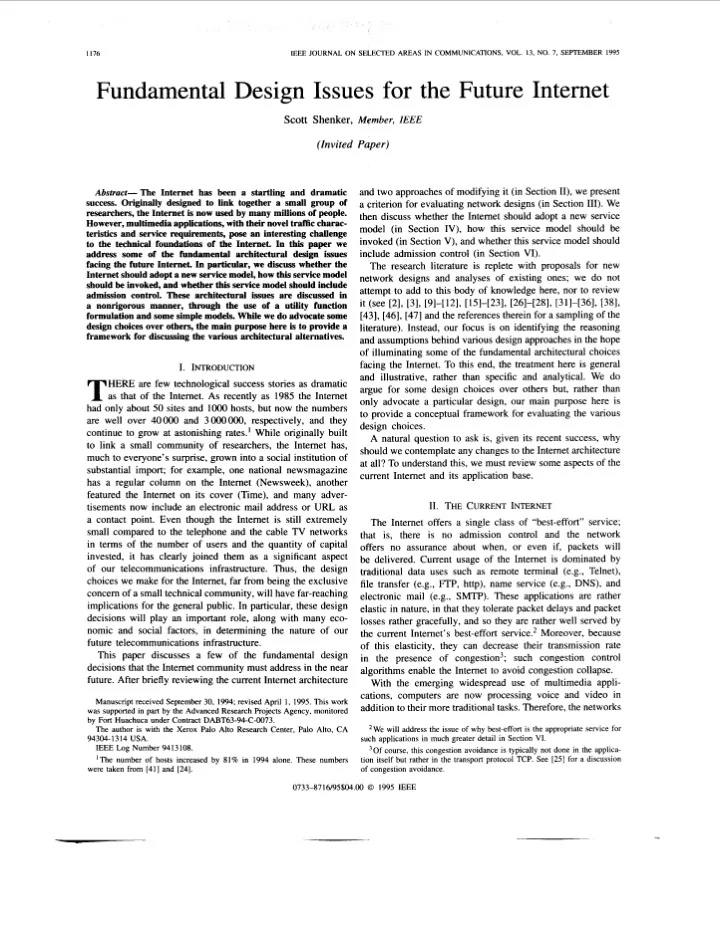

IEEE JOURNAL ON SELECTED AREAS IN COMMUNICATIONS, zyxwvutsrqponmlkjihgfedcbaZYXWVUTSRQPONMLKJIHGFEDCBA 1 zyxwvutsrqponmlkjihgfedcbaZYXWVUTSRQPONMLKJIHGFEDCBA Scott Shenker, zyxwvutsrqponmlkjihgfedcbaZYXWVUTSRQPONMLKJIHGFEDCBA VOL. 13, NO. 7, SEPTEMBER 1995 I76 Fundamental Design Issues for the Future Internet Member, IEEE teristics and service requirements, pose zyxwvutsrqponmlkjihgfedcbaZYXWVUTSRQPONMLKJIHGFEDCBA (Invited Paper) to the technical foundations of the Internet. In zyxwvutsrqponmlkjihgfedcbaZYXWVUTSRQPONMLKJIHGFEDCBA Abskuct- The Internet has been a startling and dramatic and two approaches of modifying it (in Section 11), we present success. Originally designed to link together a small group of a criterion for evaluating network designs (in Section 111). We researchers, the Internet is now used by many millions of people. then discuss whether the Internet should adopt a new service However, multimedia applications, with their novel traffic charac- model (in Section IV), how this service model should be an interesting challenge invoked (in Section V), and whether this service model should this paper we include admission control (in Section VI). address some of the fundamental architectural design issues facing the future Internet. In particular, we discuss whether the The research literature is replete with proposals for new Internet should adopt a new service model, how this service model network designs and analyses of existing ones; we do not should be invoked, and whether this service model should include attempt to add to this body of knowledge here, nor to review admission control. These architectural issues are discussed in it (see [21, [31, [91-[121, [151-[231, [261-[281, [311-[361, W I , a nonrigorous manner, through the use of a utility function formulation and some simple models. While we do advocate some [43], [46], [47] and the references therein for a sampling of the design choices over others, the main purpose here is to provide a literature). Instead, our focus is on identifying the reasoning framework for discussing the various architectural alternatives. and assumptions behind various design approaches in the hope of illuminating some of the fundamental architectural choices facing the Internet. To this end, the treatment here is general I. INTRODUCTION T and illustrative, rather than specific and analytical. We do HERE are few technological success stories as dramatic argue for some design choices over others but, rather than as that of the Internet. As recently as 1985 the Internet only advocate a particular design, our main purpose here is had only about 50 sites and 1000 hosts, but now the numbers to provide a conceptual framework for evaluating the various are well over 40000 and 3000000, respectively, and they design choices. continue to grow at astonishing rates.’ While originally built A natural question to ask is, given its recent success, why to link a small community of researchers, the Internet has, should we contemplate any changes to the Internet architecture much to everyone’s surprise, grown into a social institution of at all? To understand this, we must review some aspects of the substantial import; for example, one national newsmagazine current Internet and its application base. has a regular column on the Internet (Newsweek), another featured the Internet on its cover (Time), and many adver- 11. THE CURRENT INTERNET tisements now include an electronic mail address or URL as a contact point. Even though the Internet is still extremely The Internet offers a single class of “best-effort” service; small compared to the telephone and the cable TV networks that is, there is no admission control and the network in terms of the number of users and the quantity of capital offers no assurance about when, or even if, packets will invested, it has clearly joined them as a significant aspect be delivered. Current usage of the Internet is dominated by of our telecommunications infrastructure. Thus, the design traditional data uses such as remote terminal (e.g., Telnet), choices we make for the Internet, far from being the exclusive file transfer (e.g., FTP, http), name service (e.g., DNS), and concern of a small technical community, will have far-reaching electronic mail (e.g., SMTP). These applications are rather implications for the general public. In particular, these design elastic in nature, in that they tolerate packet delays and packet decisions will play an important role, along with many eco- losses rather gracefully, and so they are rather well served by nomic and social factors, in determining the nature of our the current Internet’s best-effort service.’ Moreover, because future telecommunications infrastructure. of this elasticity, they can decrease their transmission rate This paper discusses a few of the fundamental design in the presence of congestion3; such congestion control decisions that the Internet community must address in the near algorithms enable the Internet to avoid congestion collapse. future. After briefly reviewing the current Internet architecture With the emerging widespread use of multimedia appli- cations, computers are now processing voice and video in Manuscript received September 30, 1994; revised April 1, 1995. This work addition to their more traditional tasks. Therefore, the networks 0733-8716/95$04.00 zyxwvutsrqponmlkjihgfedcbaZYXWVUTSRQPONMLKJIHGFEDCBA was supported in part by the Advanced Research Projects Agency, monitored by Fort Huachuca under Contract DABT63-94-C-0073. The author is with the Xerox Palo Alto Research Center, Palo Alto, CA We will address the issue of why best-effort is the appropriate service for 94304-1314 USA. such applications in much greater detail in Section VI. IEEE Log Number 9413108. ’Of course, this congestion avoidance is typically not done in the applica- ‘The number of hosts increased by 81% in 1994 alone. These numbers tion itself but rather in the transport protocol TCP. See [25] for a discussion were taken from [41] and [24]. of congestion avoidance. 0 1995 IEEE
Recommend
More recommend